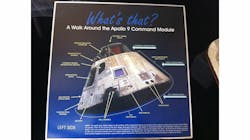New Space Vehicle Orion Launching December 4th; Apollo 9 On Exhibit at San Diego Air & Space Museum
San Diego, CA - December 3, 2014 - With the impending launch of the brand new Orion spacecraft, NASA is returning to the type of spacecraft America flew to the moon four decades ago. Just as this Orion launch is a precursor to returning people to deep space, so the San Diego Air & Space Museum's Apollo 9 spacecraft was a vital stepping-stone for astronauts to land on the moon in the summer of 1969.
Jim Kidrick, President & CEO of the Museum said, "The launch tomorrow may very well re-establish our nation’s leadership in deep space exploration...it's time to pay attention to the successes we hope will come from the launch, and our Navy's recovery process. It's very exciting."
Of special note, Air & Space Museum Board Member Mort Jorgensen, MD, served as a member of the medical team during the recovery of Apollo 8 (on the USS Yorktown) and Apollo 11 (on the USS Hornet). He describes the experience as a once-in-a-lifetime opportunity, he remembers to this day...
Flown in the spring of 1969, mere months before the first moon landing, Apollo 9 thoroughly tested all of the equipment needed to ensure Neil Armstrong’s mission would be successful. In much the same way, the Orion test flight plans to prove the worth of the spacecraft before more ambitious missions are attempted.
Though their designs are half a century apart, the two spacecraft types even look the same: a blunt, conical shape. This is due to physics: they both use the best possible shape to safely return through Earth's atmosphere. The space shuttle, which flew in between the Apollo and Orion programs, used wings, which is a very different approach, especially when the Shuttle returned from near earth orbit, it was essentially a glider as it returned to earth. Orion even uses a near-identical heat shield material as Apollo.
Inside the spacecraft, there are many common features: And in Orion astronauts will recline in special couch-like seats. Orion however incorporates the best of cutting-edge, 21st century technology, which are significant improvements from the Apollo program.
Nevertheless, NASA engineers and astronauts have saved time and money by intensely studying the design genius of the Apollo spacecraft. This has included numerous visits to the San Diego Air & Space Museum to study Apollo 9 up-close, and understand how it was constructed, but in particular how it was equipped to facilitate an ocean recovery. The recovery is an element to success space exploration, to ensure absolute safety for the astronauts.
If all works successfully with the Orion launch, it will splash down in the Pacific Ocean, where a Navy ship will recover it and bring it to San Diego. This also happened during the Apollo missions.
Thus, visitors to the Museum can view a spacecraft from the Golden Age of space exploration, and see the same basic design of the Orion by visiting the San Diego Air & Space Museum for an up-close look at Apollo 9.
The San Diego Air & Space Museum is California's official air and space museum and education center. The Museum is an affiliate of the Smithsonian Institution, and it was the first aero-themed Museum to be accredited by the American Association of Museums. Now showing: Ripley’s Believe It or Not! a special exhibition exploring the weird and wacky world of Robert Ripley. Visit www.sandiegoairandspace.org for more information. The Museum is located at 2001 Pan American Plaza, Balboa Park, San Diego, CA 92101. The Museum and gift store are open daily from 10:00am to 4:30pm. Closed Thanksgiving Day and Christmas Day.
